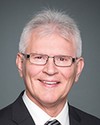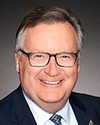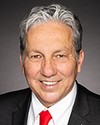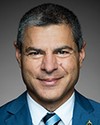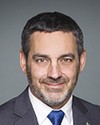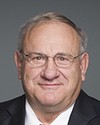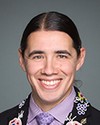moved that Bill C-374, An Act to amend the Historic Sites and Monuments Act (composition of the Board), be read the second time and referred to a committee.
Mr. Speaker, it is an honour to rise in the House to speak about my private member's bill, Bill C-374, An Act to amend the Historic Sites and Monuments Act (composition of the Board).
I would like to begin by recognizing we are on the traditional territory of the Algonquin people. As we all recognize, acknowledging traditional territories is a small but meaningful way to promote reconciliation with indigenous people.
Bill C-374 would amend section 4(d) of the Historic Sites and Monuments Act to include three new indigenous representatives on the Historic Sites and Monuments Board of Canada, or HSMBC, one each for first nations, Métis, and Inuit.
While section 4(d) of the Historic Sites and Monuments Act currently provides for one representative from each province and territory, and while there is an indigenous affairs and cultural affairs directorate from Parks Canada, there is no formal representation of indigenous peoples, organizations, or governments on the board.
Bill C-374 would address this by implementing the Truth and Reconciliation Commission's call to action 79.i, which calls upon the federal government to “amend the Historic Sites and Monuments Act to include First Nations, Inuit, and Métis representation on the Historic Sites and Monuments Board of Canada and its Secretariat.” This change is crucial to continue breaking down the walls of exclusion, which have historically existed between the federal government and indigenous people in Canada.
The fact is no relationship is more important to our government and to Canadians than the one with indigenous people. We have been clear that we are committed to a renewed relationship based on recognition of rights, mutual respect, co-operation, and partnership. It is critical we recognize the journey toward true reconciliation is far from over, and that we can and must do more in repairing our relationships with indigenous people.
Our government has been clear in our support for the Truth and Reconciliation Commission's calls to action, and indeed have made progress on 41 of them. Bill C-374 and the inclusion of indigenous persons on the Historic Sites and Monuments Board of Canada presents an opportunity for all members in this House to continue this important work.
The Historic Sites and Monuments Board of Canada plays a fundamental role in the ways in which we recognize historical persons, places, and events in Canada. It evaluates applications for designating national historic places, heritage railway stations, and heritage lighthouses.
The Historic Sites and Monuments Act grants the Historic Sites and Monuments Board of Canada the power to: receive and consider recommendations respecting the marking or commemoration of historic places; establish historic museums, and the administration, preservation, and maintenance of historic places and museums; and advise the minister in carrying out his powers under this act.
The board has the mandate to advise the Minister of Environment on the designation of national historic sites, heritage railway stations, heritage railway lighthouses, persons of national significance, and events of national significance.
Today, Canada's network of national heritage designations encompasses nearly 1,000 sites, 650 persons, and 400 events. My home province of British Columbia has 94 designated sites, 40 events, and 52 persons of national significance. Through these designations, we are able to deepen our understanding of the past, appreciate the present, create a better future.
Reconciliation involves a similar process, linking past, present, and future. To forge a new relationship with indigenous people, based on mutual respect and recognition, we must first critically re-examine Canada's history, and how that history influences our modern reality.
The changes proposed in Bill C-374 address a specific aspect of reconciliation: the designation and commemoration of historic places, persons, and events. The Government of Canada is committed to achieving reconciliation with indigenous peoples based on the recognition of rights, and through mutual respect, co-operation, and partnership.
Senator Murray Sinclair put the issue poignantly. He said, “Reconciliation is not an aboriginal problem, it is a Canadian problem. It involves all of us.”
I am hopeful that members on both sides of this House will join me in supporting Bill C-374, and help advance reconciliation with indigenous peoples in Canada. I am proud of the progress that our government has made and continues to make in advancing reconciliation with indigenous peoples.
Our government took the unprecedented move of dismantling the paternalistic and colonist approach to indigenous affairs, creating two new federal departments: Crown-Indigenous Relations and Northern Affairs, and Indigenous Services. We recognized that a new relationship required new structures.
Further, we have committed a new integrated approach to Jordan's principle, resulting in 1,500 additional children now receiving care. We committed full support of, and commitment to fully implement, the United Nations Declaration on the Rights of Indigenous Peoples. We launched a national inquiry on missing and murdered indigenous women and girls. We developed bilateral mechanisms with indigenous organizations to develop policy on shared priorities.
This last point, new bilateral mechanisms, is one I would like to highlight in particular as it reflects our government's commitment to new ways of engaging with indigenous peoples, as well as ensuring their voices are represented in government decision-making processes. That is why the bill is so important. It would ensure indigenous persons would be given a voice at the decision-making levels of the Historic Sites and Monuments Board of Canada.
How can we expect to accurately commemorate our heritage spaces if we lack the voices of first peoples of this land?
The need for inclusion of indigenous voices in commemorating our past was highlighted through the recent work of the Standing Committee on Environment and Sustainable Development, a committee on which I participate. As members in this place will know, our committee recently tabled a study on the state of heritage preservation in Canada, entitled “Preserving Canada's Heritage: the Foundation for Tomorrow.”
The Standing Committee on Environment and Sustainable Development believes the federal government needs to take stronger action to preserve Canada's historic places. During our study, we heard from numerous witnesses. During his appearance before the committee, Mr. Ry Moran, director of the National Centre for Truth and Reconciliation, reminded the committee about the Truth and Reconciliation Commission's recommendations regarding the protection and conservation of indigenous heritage in Canada.
Mr. Moran expressed particular concern about the state of conservation of the 17 remaining residential schools if nothing was done to preserve them. He explained to the committee that some indigenous communities wanted to preserve these residential schools as evidence of history. However, he said that it was easier to obtain funding to demolish these schools. Mr. Moran noted that indigenous communities wanted to be able to choose whether they preserved or demolished these buildings. Moreover, he emphasized the need to commemorate the places where demolished residential schools once stood, as the Truth and Reconciliation Commission recommended.
The committee heard that the inclusion of indigenous people was a priority and a necessity for the heritage community; that today's heritage organizations, departments, and agencies were ill-equipped to protect and preserve indigenous heritage; that indigenous people must be involved in defining, designating, commemorating, and preserving their heritage; and that indigenous communities, governments, and organizations wanted to have a voice and a place for their people to have a voice in heritage conservation.
Ms. Joëlle Montminy, vice-president of indigenous affairs and cultural heritage directorate, Parks Canada Agency, commented:
...we have started engaging with the National Centre for Truth and Reconciliation, for instance, specifically on call to action 79(iii), the aspects of commemorating the legacy of residential schools. We're looking at how we're going to be implementing that. There's also, as you know, under 79, the appointment of members to the board—indigenous members, Métis, first nations, and Inuit. We're working on that, and that will done in consultation with indigenous groups. There's also the other section of 79, in relation to reviewing our policies, protocols, and practices to make sure we are inclusive of indigenous perspectives and voices...of the board.
Bill C-374 would directly support this work by Parks Canada by creating the legislative framework to implement call to action 79(i).
Mr. Christophe Rivet, president of ICOMOS Canada, also provided testimony to the recent study. He noted:
I will certainly not pretend to speak on behalf of indigenous people. However, I will share some of the echos of what we've heard, and we have indigenous people on our board of directors. What we see is that Canada is not equipped to deal with protecting things that are important to our indigenous people. It does so through certain legislation, but there are some big challenges. One of them is the protection of cultural landscapes. Another is the protection of archeological sites. These are significant shortcomings in thinking about how to, for example, implement the Declaration on the Rights of Indigenous Peoples. This is something we are noticing, and this is why our committee is looking at it as a priority. We feel ill-equipped to respect, express, and protect the world vision of the many indigenous communities.
Returning to Mr. Moran's testimony, he further noted:
This is an exceptionally important conversation that we're going to have here, and not only in regard to heritage. What I will be presenting strikes at the very heart of our national identity: what we choose to remember, what we choose to forget, and the essential requirement asked of us as Canadians to preserve and remember a history that is deeply troubling, has been deeply damaging, and will continue to affect this country for generations to come.
He further stated:
Central within those calls to action are a number of calls related directly to commemoration. Those commemoration calls relate directly to the creation or establishment of a “national memory” and our ongoing need as a country to make sure we continue to shine light into the darkest corners of our history.
He went on to say, “We know there's broad support for implementing those calls to action.”
Karen Aird, president, and Madeleine Redfern, director, of the Indigenous Heritage Circle, also provided testimony.
Karen Aird stated:
...in this time, this time of reconciliation, this time when we see a new change in government, there's a need for people to start thinking differently about heritage, and moving it beyond built heritage, and thinking...how indigenous people perceive it and how we want to protect it. We do have our own mechanisms. We do have our own methods and approaches to protecting and interpreting heritage, and we feel it's really time...for indigenous people to have a voice in this.
She goes on to say, “There's a need for a voice and a place for people to have a voice.”
Ms. Lisa Prosper provided testimony. She stated:
The apparatus that we have in place—not just us, it's the heritage apparatus—is born out of a particular trajectory, and is, in my opinion, ill-equipped to currently address the context of indigenous cultural heritage.
She also stated:
...I would say that the broad objective should be to get to a place where the indigenous community sees themselves reflected back to them in what is recognized as Canadian heritage....The immediate steps are to work within existing frameworks. If the Historic Sites and Monuments Board is the vehicle by which...[this] can happen, and then therefore the recognition of important sites to commemorate, if you want, a sort of backlog of potential sites for commemoration, is a possibility, and some sort of recognition of the residential school system and various other elements that are out there.
Prior to working in politics, I was a long-time worker with Parks Canada and had the opportunity to manage a number of national historic sites. I was also involved with the commemorations program. Here are some examples.
One that I turn to is Yuquot. It is an amazing site on the west coast of Vancouver Island. It was commemorated first in 1923 as Friendly Cove. It was designated as a place discovered by James Cook in March of 1778. Yuquot or Friendly Cove is the heart of the Mowachaht/Muchalaht community from the beginning of time. It was really the heart of their social, political, and economic world. In 1985, through lobbying of the Mowachaht/Muchalaht community, the Historic Sites and Monuments Board of Canada revisited that commemoration and commemorated it for what it actually is, the heart of the Mowachaht/Muchalaht nation, and the point where the first contact with Europeans happened. This is the kind of voice that an indigenous perspective can bring to these very important conversations.
I will say that Parks Canada works with 300-plus indigenous partners and communities on the conservation, restoration, and presentation of natural and cultural spaces. All of these accomplishments reflect progress made in Canada's relationship with indigenous peoples. Despite these facts, Canada's network of historic designations reflects a rather narrow view of the past. For millennia, indigenous peoples have thrived on this land. They farmed, fished, and hunted. They established vast trade networks, and celebrated their heritage. Reconciliation involves a multi-faceted, deliberate, and ongoing process. Many call it a journey. Along the way, we must acknowledge the wrongs of the past, learn more about the diversity of our history, and work together to implement indigenous rights.
As it stands today, Canada's historic designation system is outdated. Many past designations, along with the board's composition, are rooted in this country's colonial history. We should celebrate Canada's entire past. We should tell a broader, more inclusive, and more accurate story.
This is an issue that impacts all Canadians, and we have a unique opportunity for members of this House of Commons to come together and advance the process of reconciliation. To that end, I am asking my hon. colleagues to support Bill C-374.



